With the horses I’ve recently trained to Grand Prix—Galant, Pikko del Cerro, Denzello—I think of their mental and physical development in terms of layers. Sometimes the horse’s body may develop when the mind is still immature and then the mind catches up to the body or vice versa. Paying attention to that is an important aspect of my training. For example, Galant was physically ready for the 6-year-old championships, but I didn’t take him. He was mentally too immature, so it wouldn’t have been an educational experience for him. As you go up the levels, be aware of where your horse is mentally as well as physically. This will help you understand that patience may be needed if your horse is more immature mentally than he is physically.
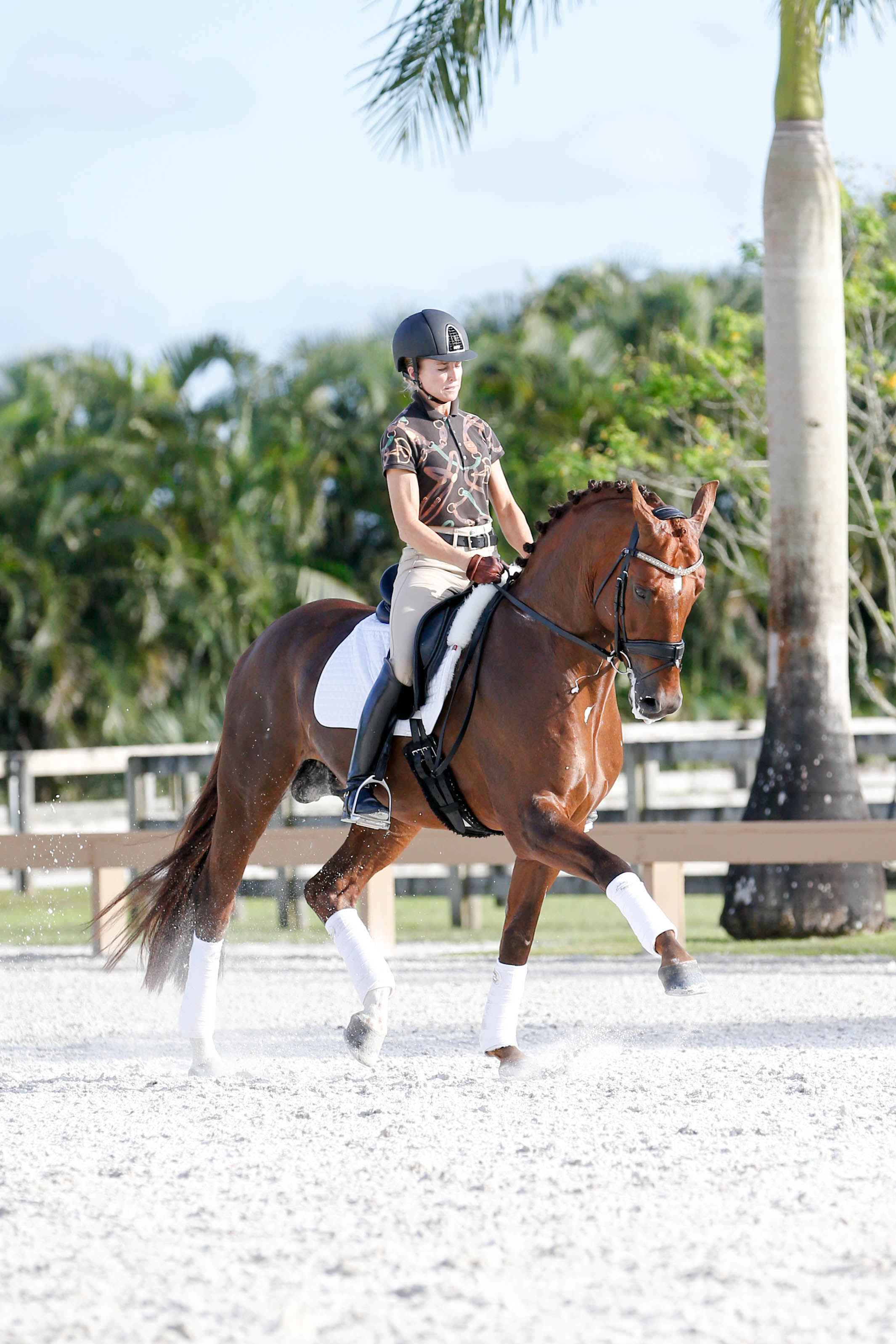
Throughness has a lot to do with mental development. An immature mind might react to a flag that snaps when it’s windy and cold. When a horse is more mature, he’s more likely to listen to the rider and be attentive to the rider’s aids. I like to expose my young horses to interesting venues as non-compete horses when they are young to help them learn to enjoy new places without stress. Galant gained confidence by experiencing these venues often. With mentally sensitive horses, consistency brings confidence. Consistency when focusing on balance, straightness and throughness is a huge plus as the degree of difficulty increases. When you finally make it into the Grand-Prix arena, if you have a little deficit there, it affects harmony.
Throughness and The Underneck
In addition to the horse’s mental development, we must also be aware of how the horse’s underneck can prevent throughness. The underneck is often the place that prevents the horse’s energy from flowing through from back to front. Tension or holding of the underneck serves as a kind of dam—a wall—that stops the energy. When the underneck relaxes, the crest of the neck lowers, and that’s when you see that beautiful arc in the middle of the neck. When this muscle is visible, the horse is carrying his neck. This muscle enables the development of the topline. With training, that muscle becomes very well defined. Unfortunately, too often horses are developing very strong undernecks. The overdeveloped underneck can be related to the horse’s conformation (low set-on neck) or sometimes it’s because the rider is holding on to the rein to keep her balance in the saddle, which causes the horse to hold with the underneck to support the rider.
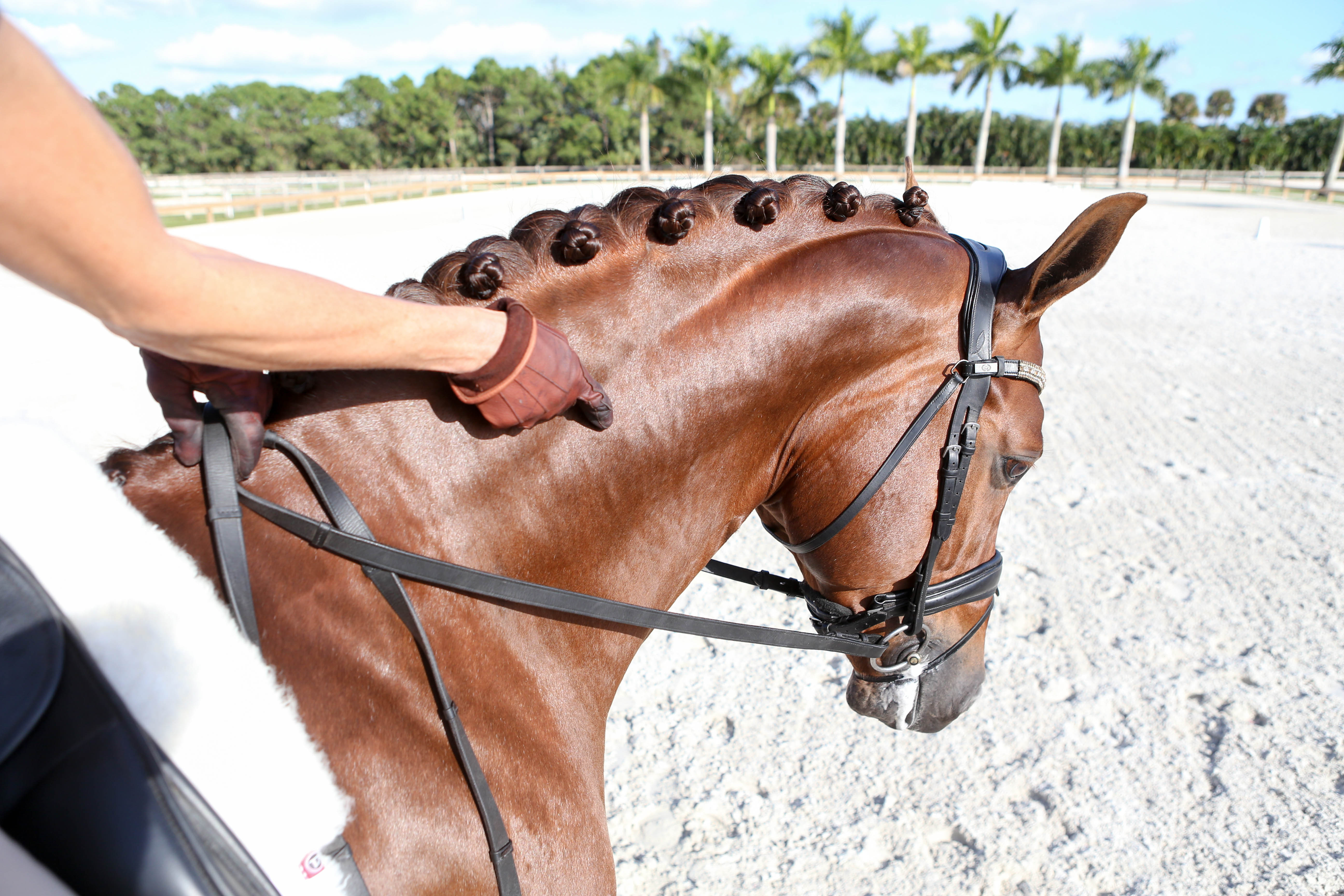
In this article, I’ll explain how your half halts can relax your horse’s underneck so his energy can go through his entire body. But first, let’s look at the rider’s position, the aids and the use of shoulder-fore to balance your horse.
Seat and Position
The rider will not be able to achieve throughness if she is not properly balanced in the tack and independent of the saddle and the horse in every way. The rider must carry her hands, allowing the horse to carry his head. The horse’s mouth should not be used to keep the rider balanced in the saddle. The reins are not meant to be tow ropes for riders to water ski with. Keep the hands low, quiet and in front of the saddle at wither-height so the horse can work within the length of his entire neck. Carrying the hands at wither-height will also give you the desired straight line from the bit through the hand to the elbow. This was the hardest thing for me to learn because this takes core strength to coordinate. If your hands come back into your lap, the length of neck is negatively infringed upon, thus creating balance issues for the horse.
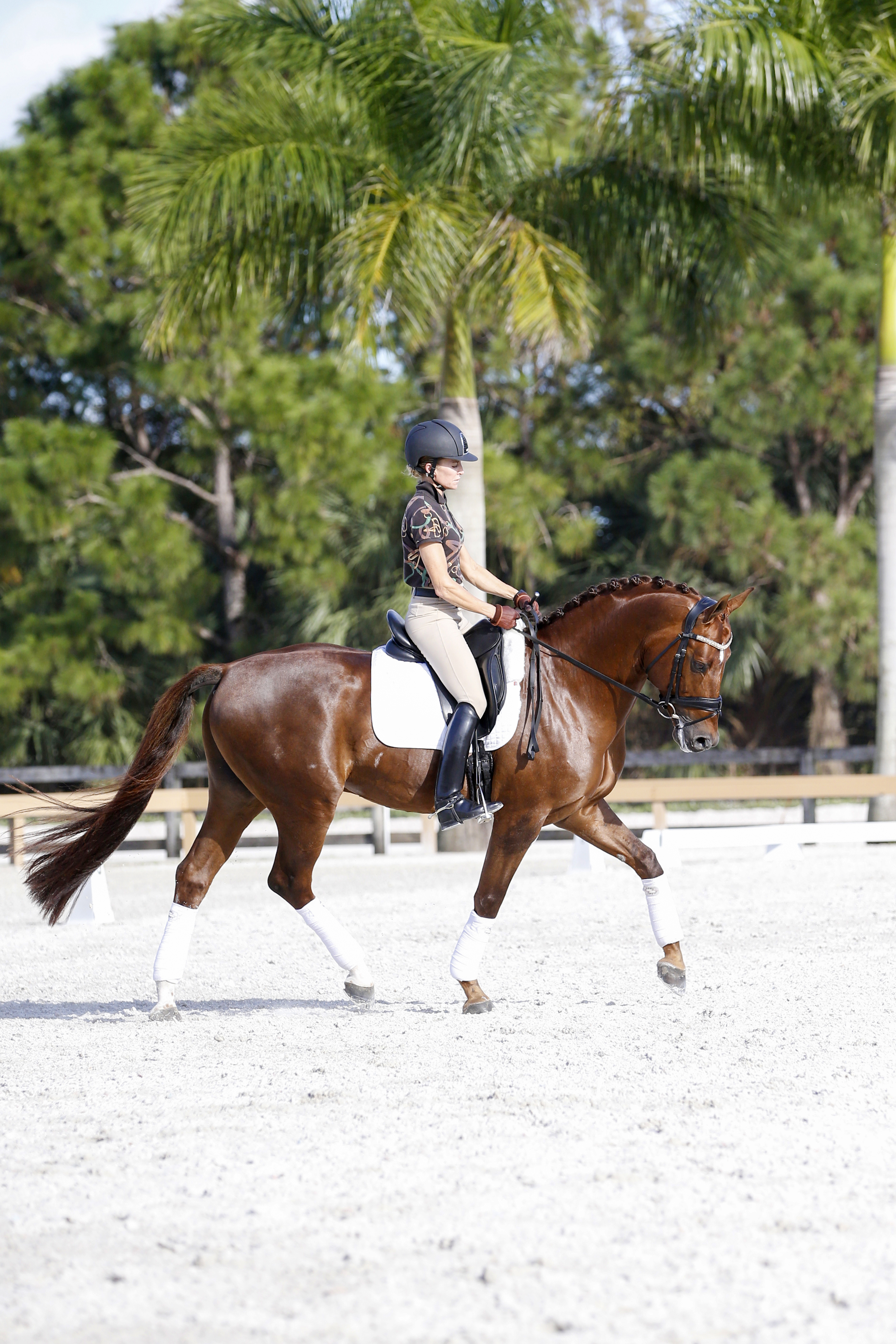
To keep yourself properly balanced:
• Stay centered in the saddle, stepping deeply into both stirrups. With the rider’s weight in the stirrups, the thighs and knees should lay loosely along the horse’s barrel. Once the rider is balanced in the saddle with stirrups weighted, the rider must then use her core to stretch tall and erect in the saddle. If you lift your chest up to sit erect, your upper body weight will be driven deep into your seat bones, thus becoming your driving seat. This has the potential to be 85 to 90 percent of the rider’s driving aid. The calf and the artificial aids are then supplements that, when used appropriately, should not create tension.
• Keep a vertical pelvis, with your shoulders directly over your hips, which are in line with your heels.
When I’m a balanced rider in every way, I can produce a balanced horse who is supple and has sufficient lateral bend. This then enables me to develop correct throughness.
Weight—The Invisible Aid
From your balanced position, always start with small aids. Less is more; never use more than you need. It’s better to start small and get no reaction and then add accordingly. Over-aiding imbalances the horse and creates tension. Aim for invisible aids.

We don’t hear much about invisible aids anymore, but they are the weight aids, and it’s surprising what you can do with your weight. If you watch Ernst Hoyos—a rider from the Spanish Riding School in Vienna for 29 years—you don’t see any aids. It’s remarkable because he’s so effective but very relaxed. Here’s how I achieve invisible aids on a circle:
As I develop bend in the body of my horse from the poll to the dock of the tail on a circle, I think mathematically. In the contact, I want one-third of the weight in my inside rein and two-thirds in my outside rein. I achieve this by using my weight accompanied by a leg impulse. I step into my inside stirrup with two-thirds of my weight to create bend. This bend then creates the two-thirds in my outside rein that I want, leaving one-third in my inside rein. More weight in my inside stirrup, accompanied by a brief leg impulse, gives me the bend needed to put more weight on my outside rein.
I always use my weight aid first by stepping deeply into my inside stirrup and then I apply a brief pressure with my leg. Horses are clever. If the rider remains consistent in her approach, the horse will understand the aids quickly. Eventually, when you step into the inside stirrup, your horse will correlate that with the brief inside leg impulse and he will respond to only the weight aid. Basically this is the “inside leg to outside rein” refined. Ideally, you won’t have to touch the horse much with your leg. Why is that ideal? Prolonged pressure creates tension, and you don’t want that. You want relaxation and harmony.
Shoulder-fore
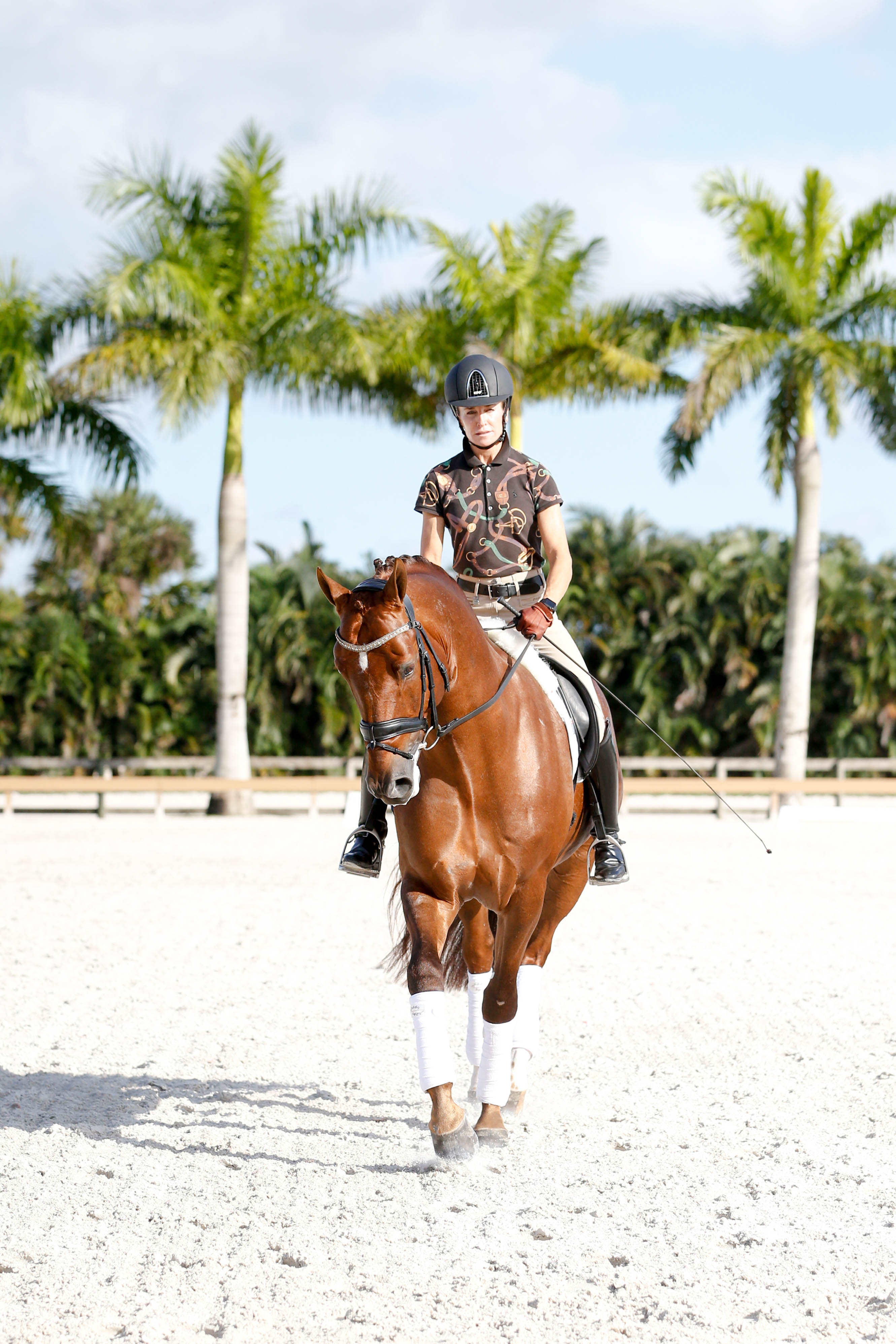
Keep your horse in shoulder-fore at all times throughout exercises and movements. It is important for the development of balance in your horse. If your car isn’t properly aligned, you’ll have a tire issue, and if your horse isn’t straight or aligned, he’ll have comparable issues.
Here’s how to achieve shoulder-fore:
1. Flex your horse slightly to the inside—just enough to see his inside eye.
2. Keep your weight in your inside stirrup (two-thirds creating bend to get two-thirds in the outside rein). The properly weighted outside rein will enable you to position the horse’s outside shoulder inward. The inside one-third rein is positioned close to the withers, making sure the shoulder does not fall in when the outside rein guides the shoulder in.
3. The horse’s outside hind leg should stay aligned with his outside foreleg. The outside hind shouldn’t be allowed to drift away or in. The rider’s guarding/driving leg prevents the outside hind leg from drifting out while requiring it to track up into the outside rein.
Now that you have a straight, balanced horse in shoulder-fore, let’s look at how the half halt can relax his underneck.
A Half Halt for Throughness
The half halt (a brief closing of both fists at the same time, supported by a securely positioned elbow and my driving leg aids) compresses both sides of the horse’s neck from wither to poll. When the fists relax, the underneck responds by relaxing. Remember that the underneck is like a wall, and you can’t get energy to flow through from back to front if it is tense or closed. When your horse yields in his underneck, the crest of the neck lowers and the withers and back raise, allowing the hindquarters to come through.
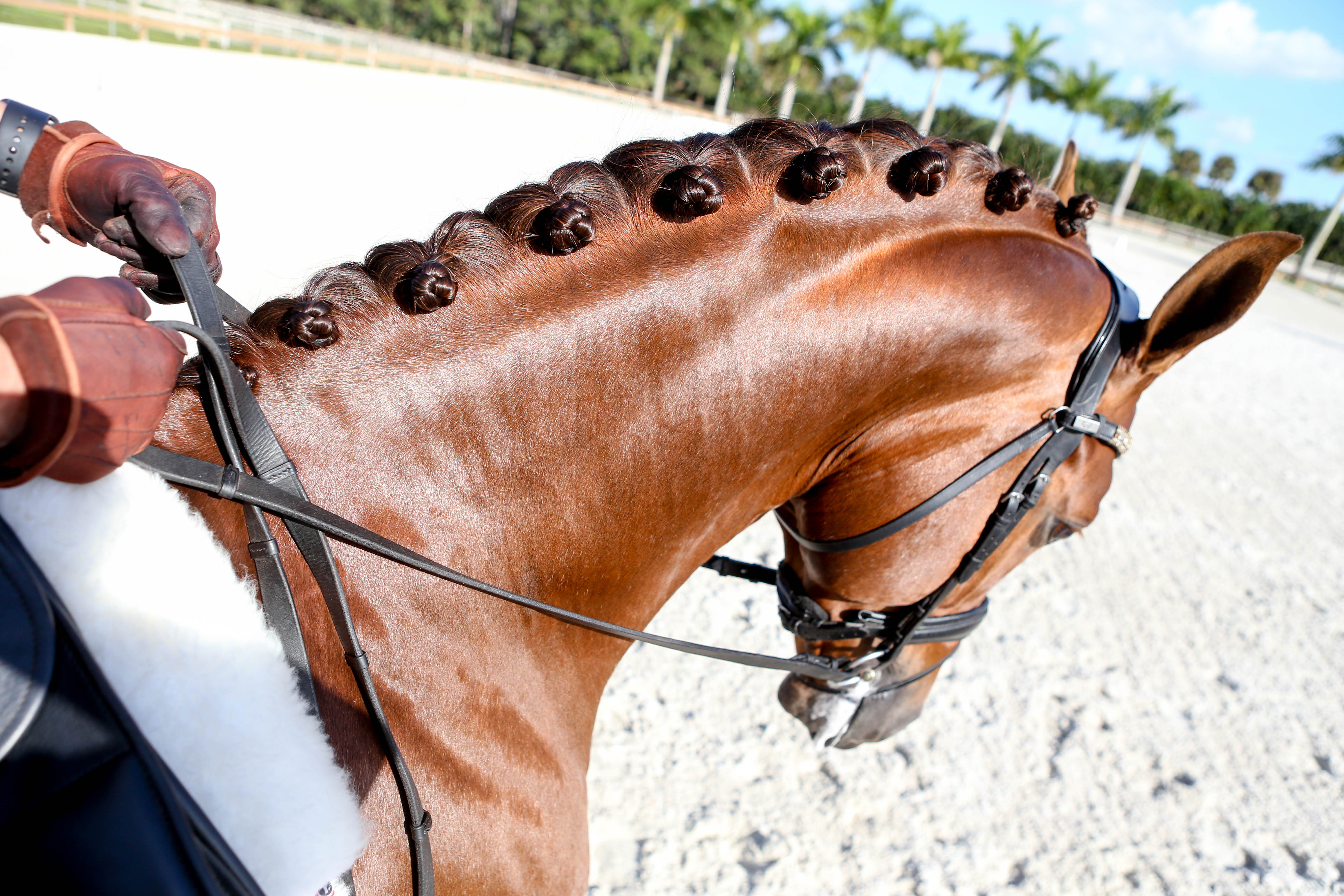
The driving aspect of the half halt is important. You always need the appropriate ratio of leg to hand—always more leg than hand because the activity of the horse’s hind leg must be enhanced by the influence of the rein aid, not stopped by or stalled by it.
Whatever I have weight-wise in my hand—say 20 pounds—then I need a 40-pound leg aid. As a result of my half halt, I want to feel the underneck relax when I relax my fist directly following the half halt. If my 20-pound half halt doesn’t work, I use a 25-pound half halt with a 50-pound leg. If the muscle relaxed from this half halt, then I have an idea of what I need to be effective. By asking the hind end to track up in every half halt, I get the flow of energy from back to front.
In the half halt, the inside leg is responsible for bend via the weight aid. My outside leg asks my horse’s outside hind to track up, staying in shoulder-fore and in front of the seat and leg. When my horse yields to the outside rein and the muscle relaxes into the contact, the inside rein softens, I end up with the desired ratio of two-thirds outside rein and one-third inside rein, making my horse supple laterally and longitudinally. Transitions and half halts within the gait in correct alignment create the longitudinal suppleness.
As for the timing, the half halt in the trot comes in the sitting phase because that’s the moment your driving seat has impact. In the canter, you half halt at the moment the poll is at the highest point. When the fist closes it must be followed by a release or relax of the ring finger. You must give after every squeeze—even if you feel that the half halt didn’t work.
You want to get the desired reaction to your half halt early in your ride as time is of the essence. You have between 45 minutes and an hour before the horse’s mental and physical batteries wear down. As soon as your horse’s underneck relaxes, the energy from behind can flow through.
The degree of throughness ideally develops through the years. A well-known example is the British star Charlotte Dujardin’s Valegro. His degree of throughness [later in his training became] much greater than it was when we first knew him. My favorite exercise for developing greater degrees of throughness is the following spiraling exercise.
Spiraling for Throughness
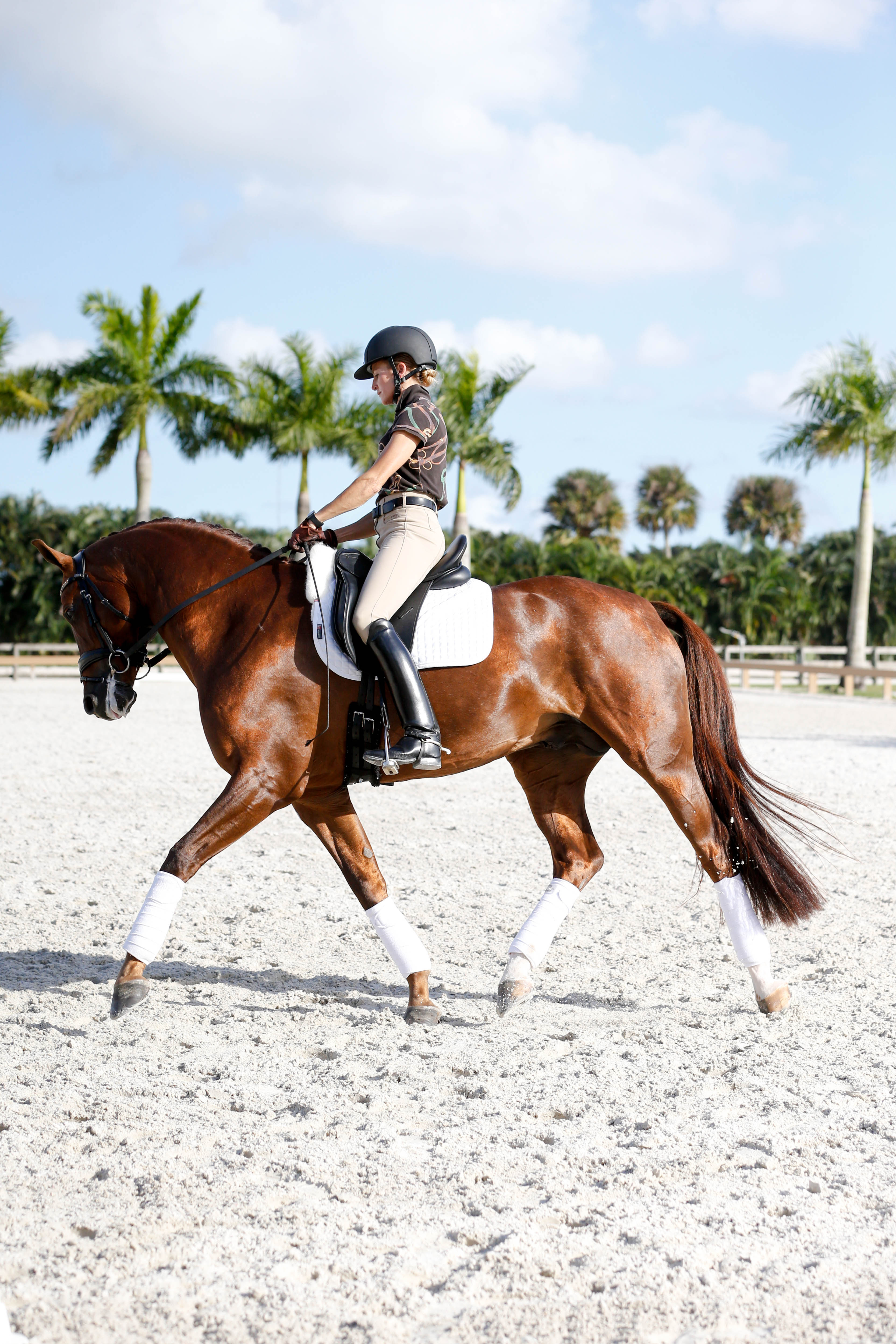
Spiraling in and out on circles while transitioning within the gait supples your horse both laterally and longitudinally and develops his throughness. Begin with your horse on a 20-meter circle, tracking right. Check your rein aids on this circle: Your hands do not sit side by side as they would, more or less, if you were going straight. With flexion and bend to the right, your aids look like this:
• The outside (left) hand needs to give the neck a bit more length in order for the horse to flex to the inside, so move it slightly toward the ear and carry it by the shoulder.
• Flex your horse to the inside (right) with your inside hand by the withers.
• Use your weight aid. Step into your inside (right) stirrup, knowing that should put more weight up in your outside rein by creating bend.
• Always think shoulder-fore.
Imagine a bird’s-eye view of your circle, and keep your horse’s shoulders turning by riding the circle like a hexagon. Your frequent guiding of the outside shoulder in will be invisible, so you end up with a smooth circle that supples your horse in proper posture and alignment.
Now spiral in. From your 20-meter circle, reduce the size to 19 meters. Do a complete 19-meter circle before going on to your 18-meter circle and then do a complete 18-meter circle. Continue with this spiral until you get to a 10-meter volte. When spiraling in, we often see the shoulders fall in, but try to maintain your desired circle size. The positioning of your hands continuously asks the shoulders to stay upright on your circle while you maintain the flexion and bend to the inside. Here’s how:
• Your left (outside) fist squeezes as it goes toward the mane in a neck rein that guides the shoulders in. At the same time, the inside rein gently squeezes to prevent the shoulder from falling in. Close both fists at the same time because you want your horse to stay upright. If you close only the inside fist, the shoulder would fall out, and if you use only the outside one, it would fall in.
• Next, your fists relax and allow the neck muscle to relax. You must give after every squeeze—even if you feel that the half halt didn’t work. You close the fists, position the shoulder, maintain the flexion and then relax both fists, which are always supported by the driving leg.
• During these half halts, the muscle will contract and then relax. Soon it will soften instantly from your half halt, rather than it taking four or five half halts. You can think of these as longitudinal-compression half halts while in bend. The muscle is compressed and then it relaxes again and again. As the upper muscle grows, the lower neck muscle atrophies and disappears.
Maintain correct alignment as you spiral in and then spiral out one meter at a time, being conscientious about the balance and shoulder-fore. Switch directions regularly so you change the bend and the outside rein to develop bilateral balance in your horse.
Testing Your Throughness
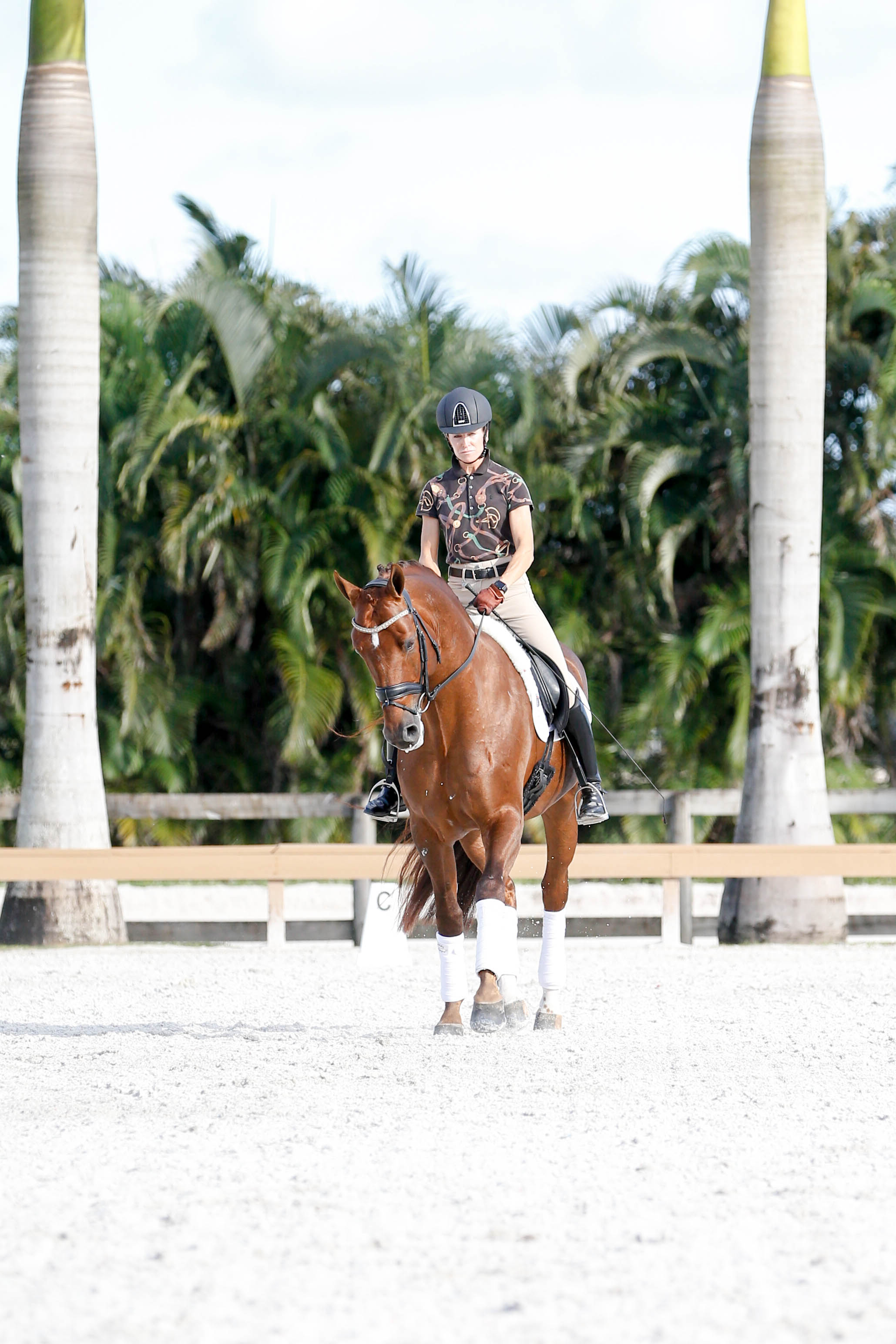
In trot rising, leave your spiraling circle and go straight on the quarterline in shoulder-in. The shoulder-in tests your contact in the outside rein and how well you’re able to control the position of the outside shoulder with it. The outside rein is the director rein. It directs where the shoulders go. Are you able to direct the shoulder-in off the track of the quarterline without losing the bend and balance? If not, you were inadvertently maintaining the bend on the circle with the inside rein. If you’re successful in going straight, can you maintain the bend, balance and activity down the entire long side? If you’re successful again, transition from shoulder-in to half pass rising. Were you successful? If so, try to do transitions within the half pass. Go to shorter strides and then back out again.
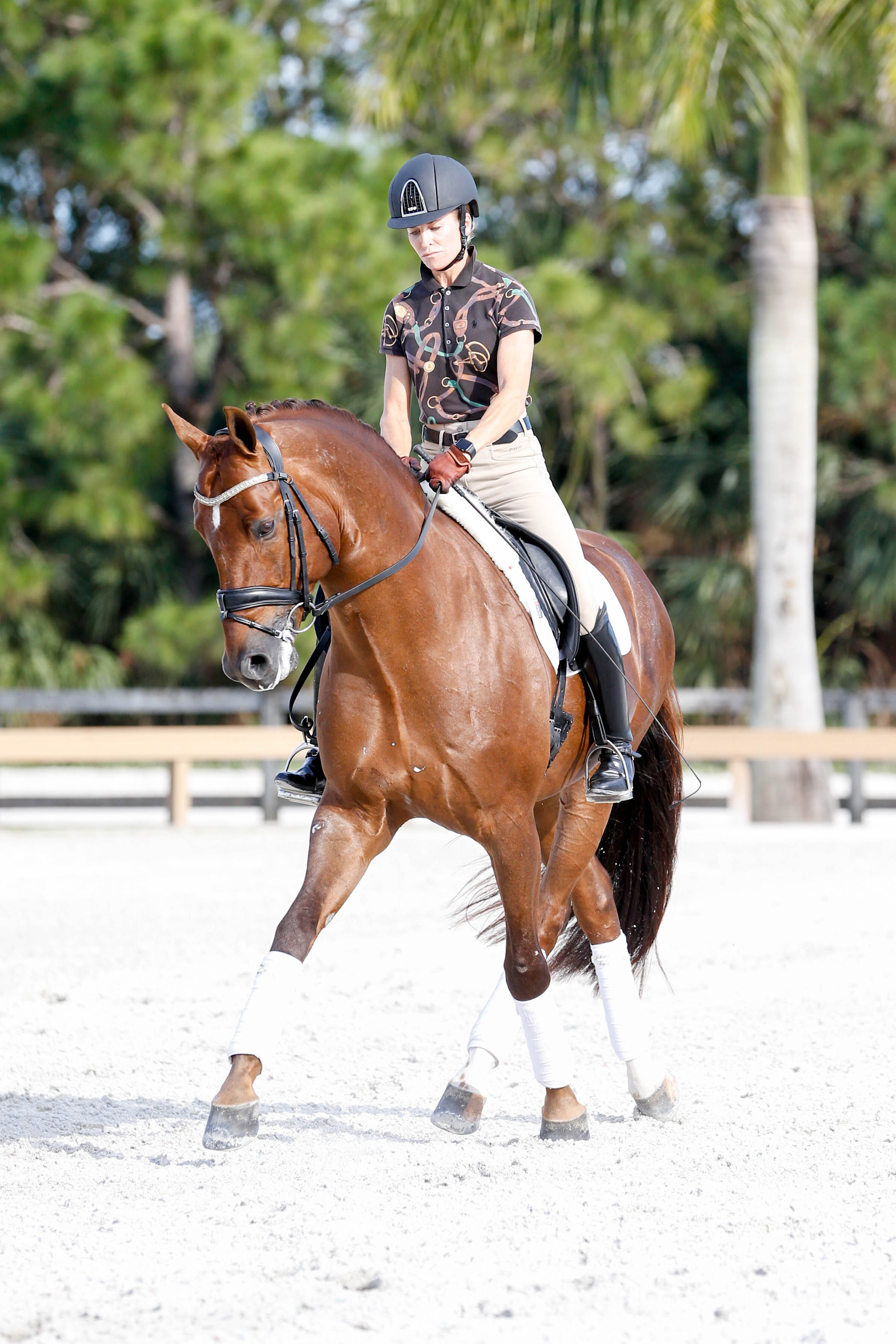
Incorporation of these exercises clarifies how well my outside rein is developing. I might find that I didn’t have the shoulder as controlled as I thought. I get readings from the neck as to how supple my horse is. I use all that information for my next phase of work. I might want to go back to the spiraling circle. Horses who don’t master the bend on a circle lose the gymnastic aspect of the sport. Don’t hesitate to go back to the circle, change directions and go back to shoulder-in and half pass, which will continue to develop your horse’s throughness. Pay attention to your arena and your lines of travel. Be aware that the steeper your half pass, the higher the degree of bend and throughness required. Preparation for each movement will build your horse’s confidence mentally along with strengthening him physically.
USDF Definition of Throughness. The state in which the rider’s aids/influences go freely through to all parts of the horse, from back to front and front to back (e.g., the rein aids go through to reach and influence the hind legs). Prerequisites for this state are good connection and positive mental/emotional state. Note: “Throughness” is a shortening of “throughlettingness,” the literal translation of the German term Durchlässigkeit.
Common Problems
Tilting. It’s common to see the horse’s head tilt so the ears are out and the nose is in. In this case, you have too much inside rein; perhaps you have two-thirds inside and one-third outside. You want to correct that by subtly straightening your horse from the wither to the poll to reconnect with the outside rein or by straightening with a slight or subtle counter-flexion. Then redevelop the inside flexion and ride from inside leg to outside rein. If the head is straight this time, you know you’ve developed the proper outside rein connection.
Wagging the head. Riders often make the mistake of flexing left and right fast and furiously, pulling the horse from one rein to the other and throwing him off balance. Horses in this situation are forced to brace the underneck muscles to help balance themselves. As a result, they are working out of alignment and therefore the risk of injuries are far greater. Keep your horse healthy over his lifetime by using subtle aids that develop his topline. Horses find comfort and confidence in the patient, quiet rider. The longer you take, the faster it goes!
Building Throughness
As you spiral to smaller circles, you’re increasing the degree of bend and throughness. Your horse’s ability to canter on a volte is a prerequisite to his ability to do a pirouette, which requires great strength and balance to stay nearly on the spot. In the first photo below, you see that my horse does a haunches-in on an 8-meter volte as a working pirouette to teach the hindquarters to be quick in preparation for pirouette. The hardest part of the pirouette is maintaining the activity of the hind leg with this highest degree of collection. When your horse carries himself easily with bend and flexion on a volte in canter, he can build the strength to pirouette gracefully with his inside hind going up and down like a piston (the second photo below). Ride this as if you are on a skateboard. Your inside foot is on the skateboard and your outside leg propels your horse so his inside hind can carry, stepping up and down like a piston.
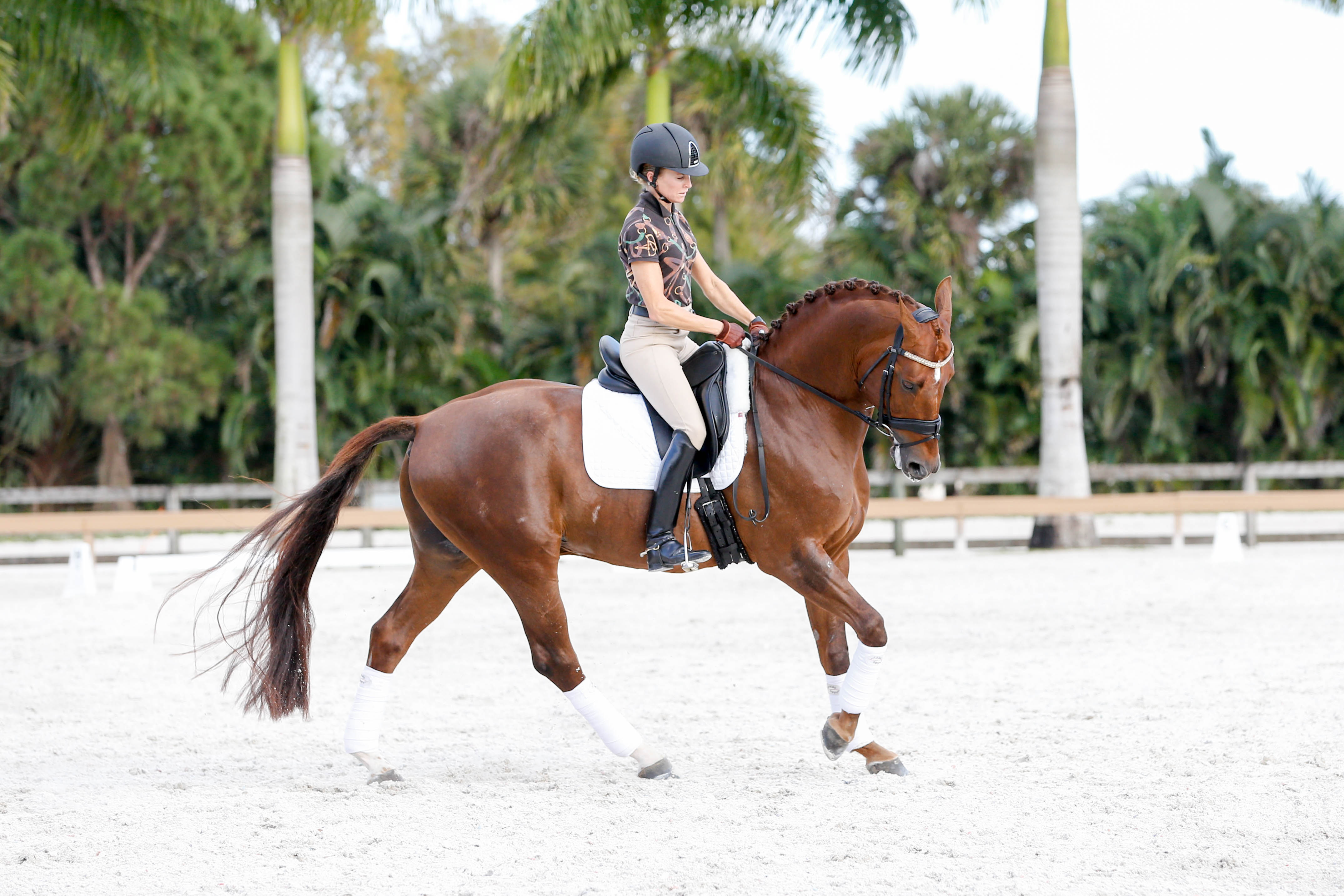
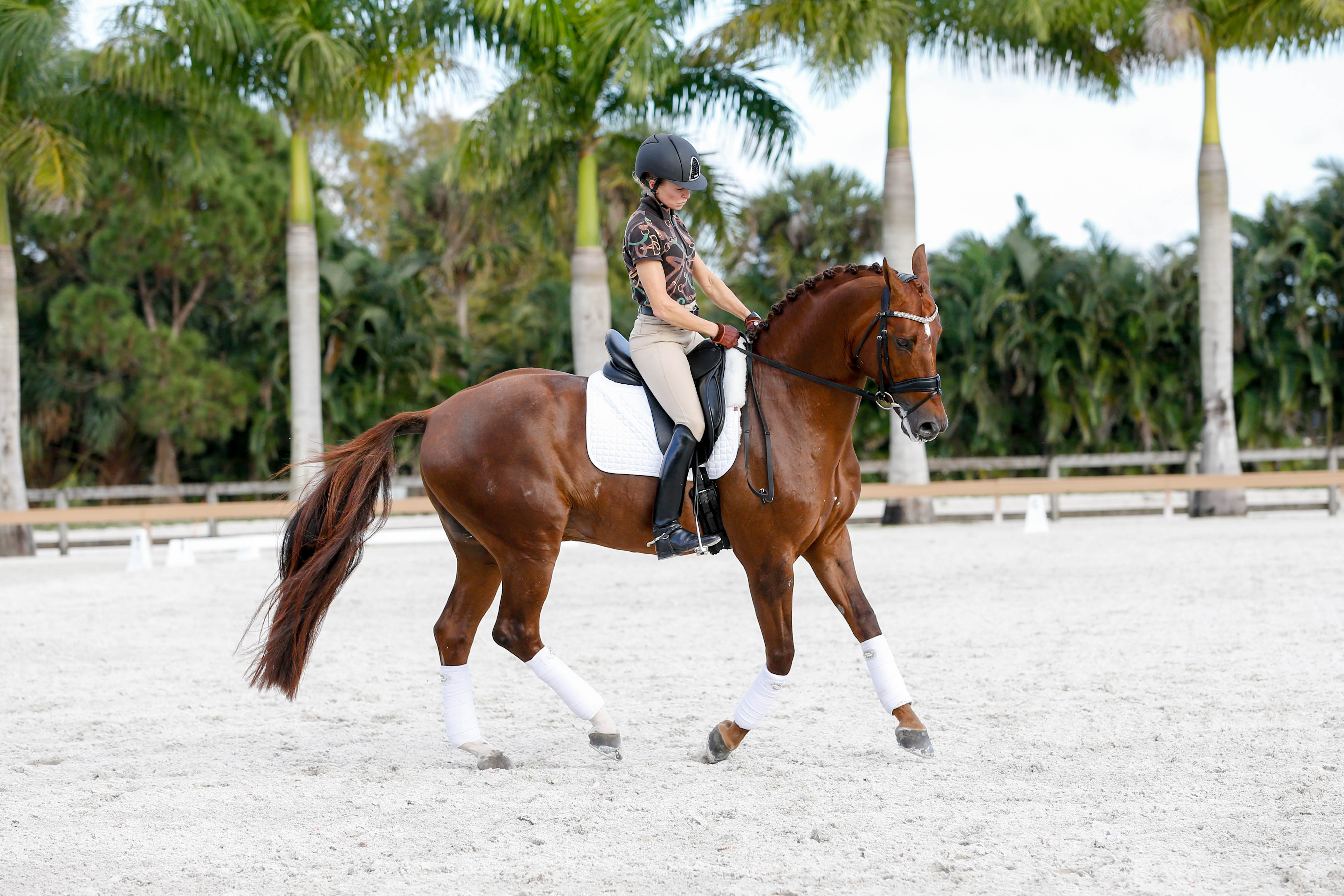
Click here to read more articles with Lisa Wilcox.
This article was first published in the March 2015 issue of Dressage Today magazine.
Lisa Wilcox lives and trains in Wellington, Florida. Her many accomplishments include a team silver medal on Relevant at the 2002 WEG and a team bronze on Relevant at the 2004 Olympic Games. In 2015 she won the National Championships for 6-year-olds with Gallant Reflection HU.











